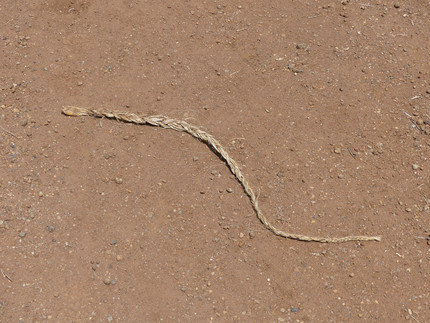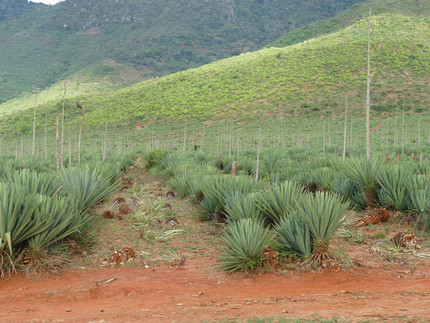Colonial fiber production: sisal and bow hemp
For centuries, the European colonial powers were on the hunt for new plant raw materials in tropical countries. As a rule, promising plants were appropriated without regard to local circumstances.1
Plants of the genus Sansevieria have traditionally been used in eastern Africa to obtain robust fibers, thus their German name 'Bogenhanf'.2,3 However, before their commercial use was developed under colonial conditions at the turn of the 20th century, Mexican sisal agaves were introduced.4 The production and utilization of their fibers were already established. As a result, large sisal plantations were quickly established. They were managed with indigenous workers who had to perform forced labor to pay their tax debts imposed by the colonial power. The close collaboration of state and private sector actors to ruthlessly exploit local labor is characteristic of colonialism.
The sisal agave was domesticated by native Mexicans before the Spanish conquest of Central America, but it was used to produce pulque (2-6% alcohol, bacterial fermentation) rather than as a fiber crop. It was not until the 19th century that fiber production from the plant began, the main producing countries at that time were what is now Indonesia and the Philippines.4
In 1893, the German botanist Richard Hindorf introduced bulbils from Florida to what is now Tanzania, leaving 62 plants to form the basis of East African sisal production. In 1903, cultivation also began in Kenya. It was not until between 1937 and 1941 that Brazil began producing sisal in a commercially significant way. Brazil began exporting sisal as early as 1946, and by 1951 it was the second largest producing country.4
The Tanzanian research institute ARI Mlingano, established in 1934 specifically for this purpose, first released seedlings of the hybrid variety H.11648 in the late 1950s, which quickly led to Tanzania becoming the most successful sisal producer in the world. This hybrid of Agave angustifolia and Agave amaniensis was also introduced into China in the 1960s and still dominates the stock there today. In East Africa, the proportion of hybrids is still higher than that of the true sisal Agave.4Agave amaniensis, a taxonomically controversial species, is named after the German experimental garden in Amani.5
Agave sisalana and Agave funkiana are both sisal agaves5. In East Africa, however, it was mainly the large A. sisalana and its hybrids that were planted.
From 1964, the market for sisal gradually collapsed due to increasing competition from synthetic fibers, and production continued to decline. Originally important producing countries such as Tanzania, Mexico or Kenya reduced their production volumes by up to 80%. Only in more recent times has the use of sisal increased again due to new applications and the rising prices for crude oil as the basis for man-made fibers.4
The German colonists in East Africa had already recognized the potential value of species of the genus Sansevieria for fiber production. However, plantation cultivation, large-scale fiber production, and the subsequent steps of commercialization were far from established when sisal was introduced in 1893.3,4
References
[1] Schneckenburger, Stefan ((2010): Auf der Jagd nach dem „Grünen Gold“: Botanische Gärten in der Zeit des Kolonialismus. Biologie in unserer Zeit 40(6): 411-419.
[2] Brown, Nicholas E. (1915): Sansevieria. A monograph of all the known species. Bulletin of Miscellaneous Information (Royal Botanic Gardens, Kew) 1915 (5): 185–261. doi.org/10.2307/4107465
[3] Sadebeck, Richard (1891): Die tropischen Nutzpflanzen Ostafrikas, ihre Anzucht und ihr ev. Plantagenbetrieb. Jahrbuch der Hamburgischen Wissenschaftlichen Anstalten 9: 203-228.
[4] Sisalfaser. Wikipdia. https://de.wikipedia.org/wiki/Sisalfaser, zuletzt geprüft am 29.3.2023
[5] Gentry, Howard Scott (1982): Agaves of Continental North America. Univ. Arizona Press.


